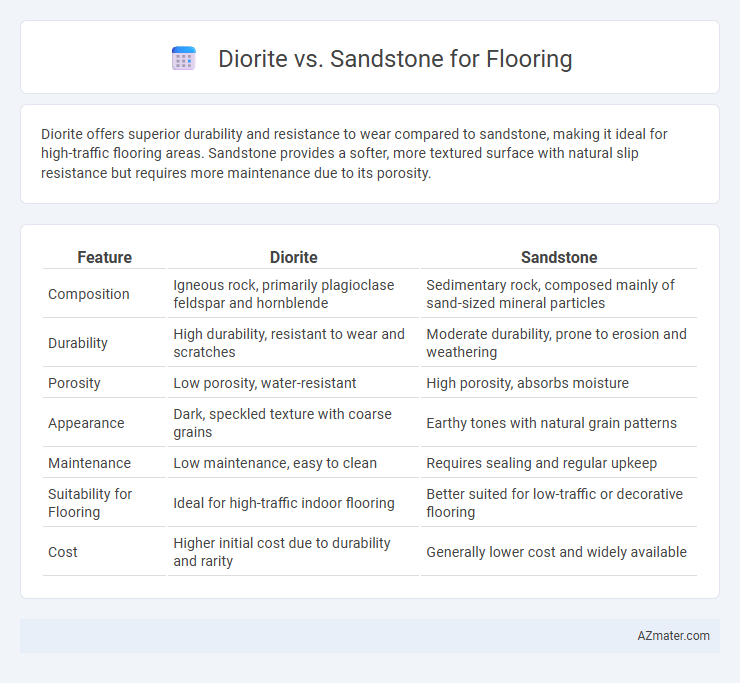Diorite offers superior durability and resistance to wear compared to sandstone, making it ideal for high-traffic flooring areas. Sandstone provides a softer, more textured surface with natural slip resistance but requires more maintenance due to its porosity.
Table of Comparison
| Feature | Diorite | Sandstone |
|---|---|---|
| Composition | Igneous rock, primarily plagioclase feldspar and hornblende | Sedimentary rock, composed mainly of sand-sized mineral particles |
| Durability | High durability, resistant to wear and scratches | Moderate durability, prone to erosion and weathering |
| Porosity | Low porosity, water-resistant | High porosity, absorbs moisture |
| Appearance | Dark, speckled texture with coarse grains | Earthy tones with natural grain patterns |
| Maintenance | Low maintenance, easy to clean | Requires sealing and regular upkeep |
| Suitability for Flooring | Ideal for high-traffic indoor flooring | Better suited for low-traffic or decorative flooring |
| Cost | Higher initial cost due to durability and rarity | Generally lower cost and widely available |
Introduction to Diorite and Sandstone Flooring
Diorite flooring offers exceptional durability and a unique, speckled appearance with its coarse-grained texture, making it ideal for high-traffic areas and modern interiors. Sandstone flooring features a natural, earthy tone and soft texture that enhances warm, rustic spaces, providing slip resistance and breathability. Both materials present distinct geological compositions, with diorite formed from intrusive igneous rock and sandstone composed of compacted sand grains, influencing their strength and aesthetic appeal.
Geological Composition: Diorite vs Sandstone
Diorite is an intrusive igneous rock composed mainly of plagioclase feldspar and hornblende, giving it a coarse-grained texture and exceptional durability suited for heavy-traffic flooring. Sandstone is a sedimentary rock primarily made of sand-sized quartz and feldspar particles cemented by silica or calcite, resulting in a softer, more porous material that is less resistant to wear. The mineral composition and formation process of diorite provide greater hardness and resistance compared to the more granular and absorbent structure of sandstone.
Durability and Strength Comparison
Diorite offers superior durability and strength compared to sandstone, making it highly resistant to wear, scratches, and heavy foot traffic. Its dense, igneous composition contributes to a harder surface, ideal for high-traffic areas and long-lasting flooring solutions. Sandstone, while aesthetically appealing with its natural grain, tends to be softer and more porous, requiring more maintenance and protection against moisture and impact.
Aesthetic Appeal and Color Options
Diorite offers a unique, speckled pattern in shades of gray, black, and white, providing a sophisticated and modern aesthetic ideal for contemporary flooring designs. Sandstone exhibits warm, earthy tones such as beige, red, and brown, creating a natural, rustic ambiance that complements traditional and outdoor spaces. Both materials offer distinct color options that cater to different interior styles, with diorite emphasizing elegance and durability, while sandstone highlights natural charm and texture.
Slip Resistance and Safety Features
Diorite offers superior slip resistance compared to sandstone due to its dense, granular texture that provides better traction underfoot, making it an excellent choice for high-traffic or wet areas. Sandstone, while visually appealing with its natural grains, tends to be more porous and can become slippery when wet unless treated with anti-slip coatings. Both materials can be enhanced with sealants and finishes, but diorite's inherent hardness and texture contribute significantly to safer flooring in residential and commercial spaces.
Maintenance and Cleaning Requirements
Diorite flooring requires minimal maintenance due to its dense, non-porous surface, making it resistant to stains and scratches, and easy to clean with mild detergents and water. Sandstone, being more porous and softer, demands regular sealing and cautious cleaning to prevent moisture absorption and surface erosion. Routine sweeping and avoiding abrasive cleaners are essential for both, but sandstone's maintenance is more intensive to preserve its natural texture and appearance.
Installation Process and Technical Considerations
Diorite flooring requires precise cutting and polishing due to its hardness and dense crystalline structure, making installation more labor-intensive and time-consuming compared to sandstone. Sandstone, being softer and more porous, allows for easier shaping and quicker installation but demands thorough sealing to prevent moisture penetration and staining. Technical considerations include diorite's superior durability and resistance to wear, making it ideal for high-traffic areas, while sandstone needs regular maintenance and careful substrate preparation to ensure long-lasting adhesion and stability.
Cost Analysis: Diorite vs Sandstone
Diorite flooring typically costs between $7 to $16 per square foot, reflecting its high durability and unique speckled appearance, while sandstone ranges from $5 to $15 per square foot, offering a softer texture with diverse color options. Installation costs for diorite tend to be higher due to its hardness, which requires specialized tools and labor, whereas sandstone's relative softness makes it easier and less expensive to install. Long-term maintenance expenses also favor diorite, as its resistance to scratching and staining reduces the need for repairs compared to the more porous and softer sandstone.
Environmental Impact and Sustainability
Diorite offers superior durability and a longer lifespan, reducing the need for frequent replacements and minimizing resource consumption over time, making it a more sustainable flooring option compared to sandstone. Sandstone extraction can lead to significant habitat disruption and higher energy use during processing, contributing to a larger environmental footprint. Choosing locally sourced diorite or sandstone with certified quarrying practices can further enhance sustainability by reducing transportation emissions and supporting responsible resource management.
Ideal Applications: Choosing the Right Stone for Flooring
Diorite offers exceptional durability and resistance to wear, making it ideal for high-traffic flooring areas such as commercial spaces and entryways. Sandstone provides a warm, natural aesthetic with moderate hardness, suitable for residential flooring and areas with lighter foot traffic. Selecting between diorite and sandstone hinges on balancing durability needs with desired texture and appearance in your flooring project.

Infographic: Diorite vs Sandstone for Flooring
 azmater.com
azmater.com